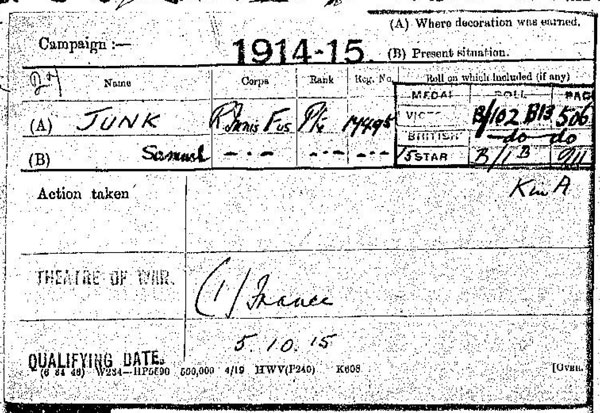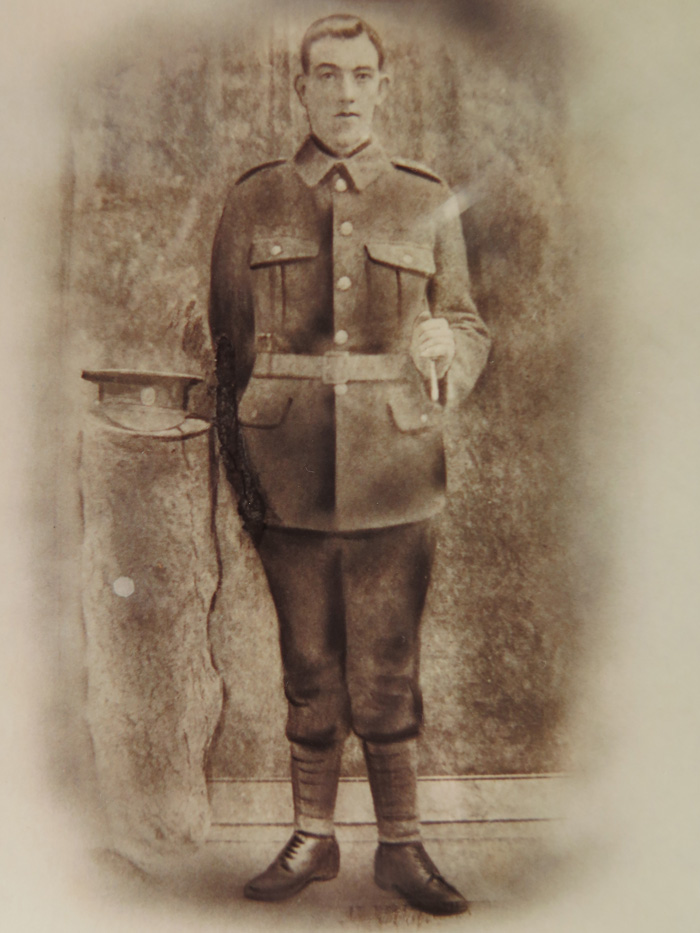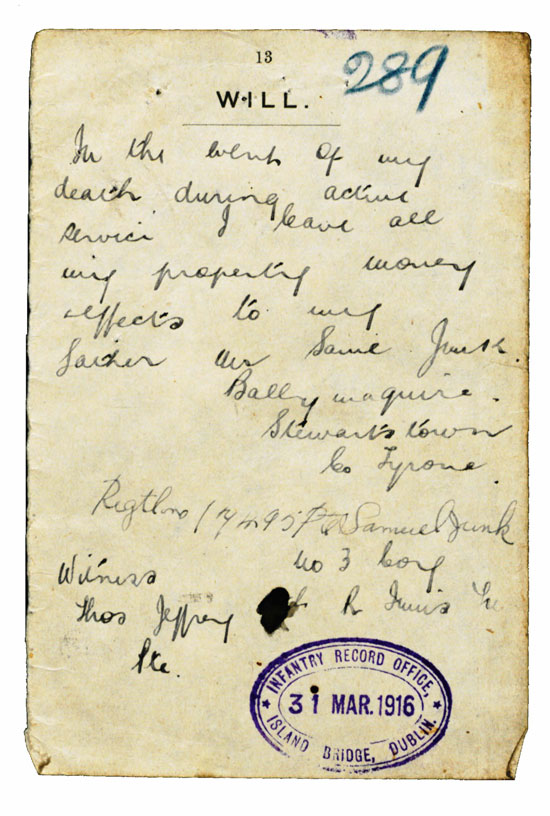| Samuel Junk was the son of Samuel and Margaret Junk. Samuel Junk married Margaret Spratt on 26th October 1894.
|
| Samuel was the only confirmed child of Samuel and Margaret. He was born about 1897 in Ardboe.
|
| The 1901 census lists Samuel as age 4, living with the family at house 4 in Ballydawley, Springhill, County Londonderry. His father was a farm labourer.
|
| Margaret Junk died in the district of Moneymore on 23rd July 1902, aged 32. GRONI references (U/1902/183/1022/17/400) the death of new born twins Margaret and Sarah on 19th July 1902. It is not known if this was a related event.
|
| Samuel’s father, Samuel Junk, married Sarah Spratt on 13th November 1902 in the district of Cookstown. It seems plausible that this was Margaret’s younger sister.
|
| Samuel and Sarah went on to have at least three children.
|
| Known family 2: Samuel Junk, Sarah Ann Junk, William Junk (born 21st August 1904), Maggie Jane Junk (born 4th October 1906), Sarah Junk (born 18th August 1909).
|
| The 1911 census lists Samuel’s step-family as living at house 9 in Ballymaguire, Killycolpy, County Tyrone.
|
| The 1911 census lists Samuel as age 14, living with relatives at house 18 in Kilsally, Killycolpy, County Tyrone. He was still at school.
|
| Samuel Junk was living in Stewartstown at the outbreak of the war.
|
| He enlisted in Cookstown around 1915.
|
| Private Samuel Junk was had served with the 9th Battalion of the Royal Inniskilling Fusiliers for nearly two years by the time of the Battle of Messines in 1917.
|

|

|
| The Battle of Messines was launched on 7th June 1917 by British General Herbert Plumer’s second army, which included the 36th (Ulster) and the 16th (Irish) Divisions, near the village of Mesen in Belgium. The target for the offensive was a ridge running north from Mesen village past Wytschaete village (which the Ulster and Irish Divisions eventually overran). The ridge was a natural stronghold southwest of Ypres.
|
| For more than a year the allies had tunnelled under the German trenches and placed 455 tonnes (1,000,000 lb) of ammonal explosive. Twenty one mines were eventually placed under the German front lines. The detonation of the mines were all timed to go off at 3.10am on the morning of 7th June 1917, this was preceded by a heavy artillery bombardment. When 19 of the original 21 mines exploded, the noise was said to have been heard as far away as London, and was possibly the loudest man made noise up to that date. In Switzerland the explosions registered as an earthquake. Some estimates put the German casualties of the initial mine explosions at 10,000 men.
|
| The explosions were followed by nine divisions of infantry advancing under the cover of a creeping barrage of artillery fire.
|
| The task of the 9th Inniskillings that day was to support the 11th Inniskillings in the advance and to push through to the far side of the village of Wytschaete.
|
| Eighteen men of the 9th Inniskillings died at the Battle of Messines.
|
| Private Samuel Junk was serving with the 9th Battalion of the Royal Inniskilling Fusiliers when he was killed in action on Thursday 7th June 1917.
|
| From the Mid Ulster Mail dated 8th June 1918:
|

|
| JUNK – 7th June 1917. Killed in action, Private S J Junk, 9th Royal Inniskilling Fusiliers, son of Mr S Junk, Ballymaguire, Stewartstown.
|
|
‘When last we saw his smiling face,
|
|
He looked so strong and brave,
|
|
We little though how soon he would
|
|
Be laid in a soldier’s grave.
|
|
A lonely grave in a foreign land,
|
|
A grave we may never see,
|
|
But as long as life and memory last,
|
|
We will remember thee’
|
| Deeply regretted by his sorrowing uncle, aunt and cousins. Ballinahone, Bigbridge
|
| Last Will and Testament of Private Samuel Junk dated 3rd August 1916:
|

|

|
| WILL: In the event of my death during active service, I leave all my property, money and effects to my father Mr Samuel Junk, Ballymaguire, Stewartstown, Co Tyrone.
17495-Private Samuel Junk no 3 Company Witness Private Thomas Jeffrey. Royal Inniskilling Fusiliers. 3 August 1916.
|
| Private S Junk is buried in Irish House Cemetery in Belgium
|

|
| The two mines which failed to detonate on the morning of 7th June 1917 remained undetected until years after the war as details of their placements were lost, much to the discomfort of people who lived in the region. During a thunder storm on 17th June 1955 one of the mines detonated, the only casualty was a cow grazing in a field nearby. The second mine is thought to have been recently pinpointed, but is yet to be recovered.
|

|
